Page 9 of 30
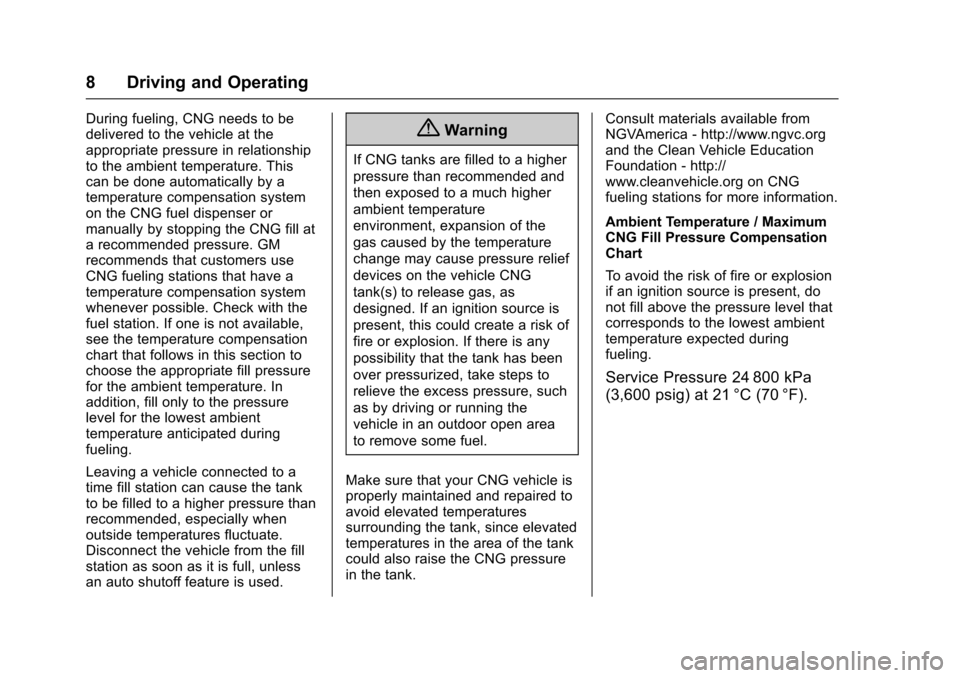
Chevrolet/GMC Express/Savana CNG Compressed Natural Gas Supplement
(GMNA-Localizing-U.S/Canada-9159237) - 2016 - crc - 6/18/15
8 Driving and Operating
During fueling, CNG needs to be
delivered to the vehicle at the
appropriate pressure in relationship
to the ambient temperature. This
can be done automatically by a
temperature compensation system
on the CNG fuel dispenser or
manually by stopping the CNG fill at
a recommended pressure. GM
recommends that customers use
CNG fueling stations that have a
temperature compensation system
whenever possible. Check with the
fuel station. If one is not available,
see the temperature compensation
chart that follows in this section to
choose the appropriate fill pressure
for the ambient temperature. In
addition, fill only to the pressure
level for the lowest ambient
temperature anticipated during
fueling.
Leaving a vehicle connected to a
time fill station can cause the tank
to be filled to a higher pressure than
recommended, especially when
outside temperatures fluctuate.
Disconnect the vehicle from the fill
station as soon as it is full, unless
an auto shutoff feature is used.{Warning
If CNG tanks are filled to a higher
pressure than recommended and
then exposed to a much higher
ambient temperature
environment, expansion of the
gas caused by the temperature
change may cause pressure relief
devices on the vehicle CNG
tank(s) to release gas, as
designed. If an ignition source is
present, this could create a risk of
fire or explosion. If there is any
possibility that the tank has been
over pressurized, take steps to
relieve the excess pressure, such
as by driving or running the
vehicle in an outdoor open area
to remove some fuel.
Make sure that your CNG vehicle is
properly maintained and repaired to
avoid elevated temperatures
surrounding the tank, since elevated
temperatures in the area of the tank
could also raise the CNG pressure
in the tank. Consult materials available from
NGVAmerica - http://www.ngvc.org
and the Clean Vehicle Education
Foundation - http://
www.cleanvehicle.org on CNG
fueling stations for more information.
Ambient Temperature / Maximum
CNG Fill Pressure Compensation
Chart
To avoid the risk of fire or explosion
if an ignition source is present, do
not fill above the pressure level that
corresponds to the lowest ambient
temperature expected during
fueling.
Service Pressure 24 800 kPa
(3,600 psig) at 21 °C (70 °F).
Page 10 of 30
Chevrolet/GMC Express/Savana CNG Compressed Natural Gas Supplement
(GMNA-Localizing-U.S/Canada-9159237) - 2016 - crc - 6/18/15
Driving and Operating 9
The refueling fill valve on the
vehicle is in the same location as
was provided originally for gasoline
refueling. Put the vehicle into
P (Park) and turn off the engineprior to refueling. Remove the dust
cap from the receptacle, clean off
any dirt or debris on the receptacle,and follow the refueling instructions
on the pump or provided by the
station operator.
Fill Valve O-Ring
If fuel or vapor is heard or seen
leaking from the nozzle-fill valve
connection, stop refueling
immediately. Dirt or other debris
may be preventing a positive
connection. Turn off the refueling
dispenser, disconnect the nozzle,
reconnect it to the fill valve, and
begin refueling again. If it continues
to leak, have an authorized dealer
inspect the sealing O-ring in the fill
valve. It may be missing, damaged,
or worn. Spare O-rings designed for
Page 11 of 30
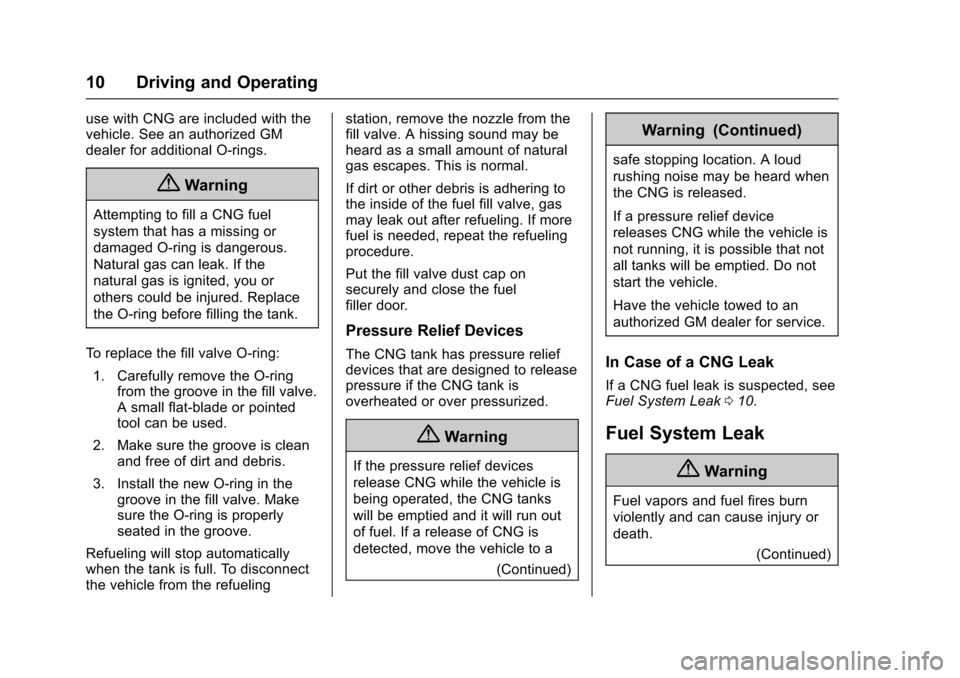
Chevrolet/GMC Express/Savana CNG Compressed Natural Gas Supplement
(GMNA-Localizing-U.S/Canada-9159237) - 2016 - crc - 6/18/15
10 Driving and Operating
use with CNG are included with the
vehicle. See an authorized GM
dealer for additional O-rings.
{Warning
Attempting to fill a CNG fuel
system that has a missing or
damaged O‐ring is dangerous.
Natural gas can leak. If the
natural gas is ignited, you or
others could be injured. Replace
the O‐ring before filling the tank.
To replace the fill valve O-ring: 1. Carefully remove the O-ring from the groove in the fill valve.
A small flat-blade or pointed
tool can be used.
2. Make sure the groove is clean and free of dirt and debris.
3. Install the new O-ring in the groove in the fill valve. Make
sure the O-ring is properly
seated in the groove.
Refueling will stop automatically
when the tank is full. To disconnect
the vehicle from the refueling station, remove the nozzle from the
fill valve. A hissing sound may be
heard as a small amount of natural
gas escapes. This is normal.
If dirt or other debris is adhering to
the inside of the fuel fill valve, gas
may leak out after refueling. If more
fuel is needed, repeat the refueling
procedure.
Put the fill valve dust cap on
securely and close the fuel
filler door.
Pressure Relief Devices
The CNG tank has pressure relief
devices that are designed to release
pressure if the CNG tank is
overheated or over pressurized.
{Warning
If the pressure relief devices
release CNG while the vehicle is
being operated, the CNG tanks
will be emptied and it will run out
of fuel. If a release of CNG is
detected, move the vehicle to a
(Continued)
Warning (Continued)
safe stopping location. A loud
rushing noise may be heard when
the CNG is released.
If a pressure relief device
releases CNG while the vehicle is
not running, it is possible that not
all tanks will be emptied. Do not
start the vehicle.
Have the vehicle towed to an
authorized GM dealer for service.
In Case of a CNG Leak
If a CNG fuel leak is suspected, see
Fuel System Leak010.
Fuel System Leak
{Warning
Fuel vapors and fuel fires burn
violently and can cause injury or
death.
(Continued)
Page 12 of 30
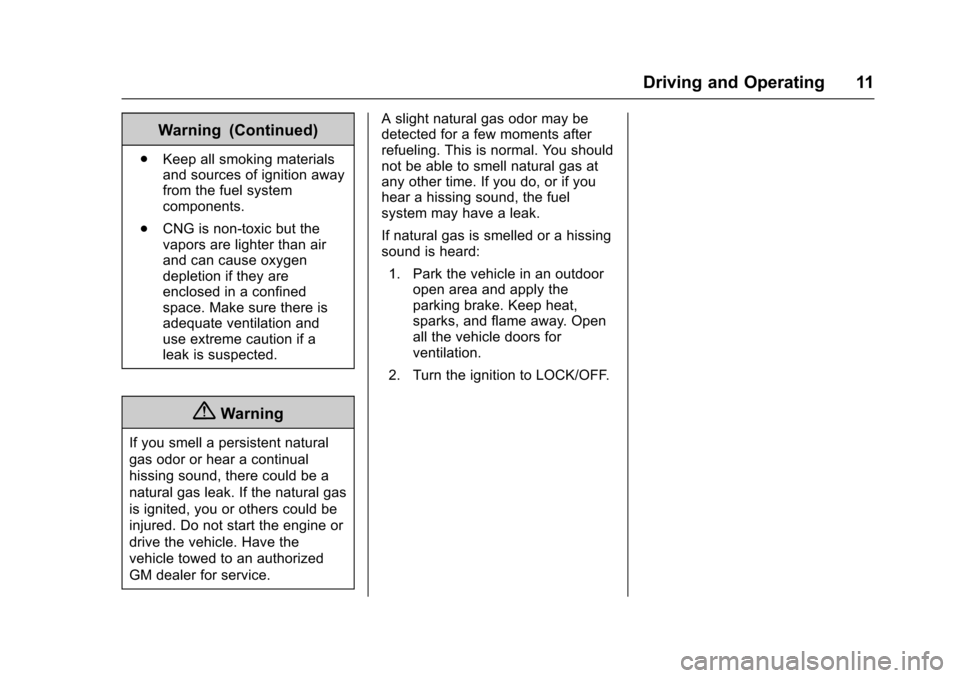
Chevrolet/GMC Express/Savana CNG Compressed Natural Gas Supplement
(GMNA-Localizing-U.S/Canada-9159237) - 2016 - crc - 6/18/15
Driving and Operating 11
Warning (Continued)
.Keep all smoking materials
and sources of ignition away
from the fuel system
components.
. CNG is non-toxic but the
vapors are lighter than air
and can cause oxygen
depletion if they are
enclosed in a confined
space. Make sure there is
adequate ventilation and
use extreme caution if a
leak is suspected.
{Warning
If you smell a persistent natural
gas odor or hear a continual
hissing sound, there could be a
natural gas leak. If the natural gas
is ignited, you or others could be
injured. Do not start the engine or
drive the vehicle. Have the
vehicle towed to an authorized
GM dealer for service. A slight natural gas odor may be
detected for a few moments after
refueling. This is normal. You should
not be able to smell natural gas at
any other time. If you do, or if you
hear a hissing sound, the fuel
system may have a leak.
If natural gas is smelled or a hissing
sound is heard:
1. Park the vehicle in an outdoor open area and apply the
parking brake. Keep heat,
sparks, and flame away. Open
all the vehicle doors for
ventilation.
2. Turn the ignition to LOCK/OFF.
Page 13 of 30
Chevrolet/GMC Express/Savana CNG Compressed Natural Gas Supplement
(GMNA-Localizing-U.S/Canada-9159237) - 2016 - crc - 6/18/15
12 Driving and Operating
3. The manual shutoff valve is onthe inner side of the driver side
frame rail halfway between the
front and rear tires. A label is on the outside of the
vehicle above the manual
shutoff valve. Do not remove
this label.Turn the lever one-quarter turn
clockwise to turn off.
Do not drive the vehicle. The vehicle
should be towed to an authorized
GM dealer.
Page 14 of 30
Chevrolet/GMC Express/Savana CNG Compressed Natural Gas Supplement
(GMNA-Localizing-U.S/Canada-9159237) - 2016 - crc - 6/18/15
Driving and Operating 13
Trailer Towing
{Warning
The trailer hitch protects the CNG
tank in a crash and from road
hazards. Damage may result in a
rupture or explosion of the CNG
tank. You or others could be
injured or even killed. If the trailer
hitch must be removed for any
reason, e.g., tank inspection or
vehicle repair, always reinstall the
trailer hitch before operating the
vehicle.
The compressed natural gas system
adds approximately 363 kg (800 lb)
of weight to the vehicle. This must
be included when determining the
maximum load and trailer towing
capacity for the vehicle as described
in the owner manual.
Page 15 of 30
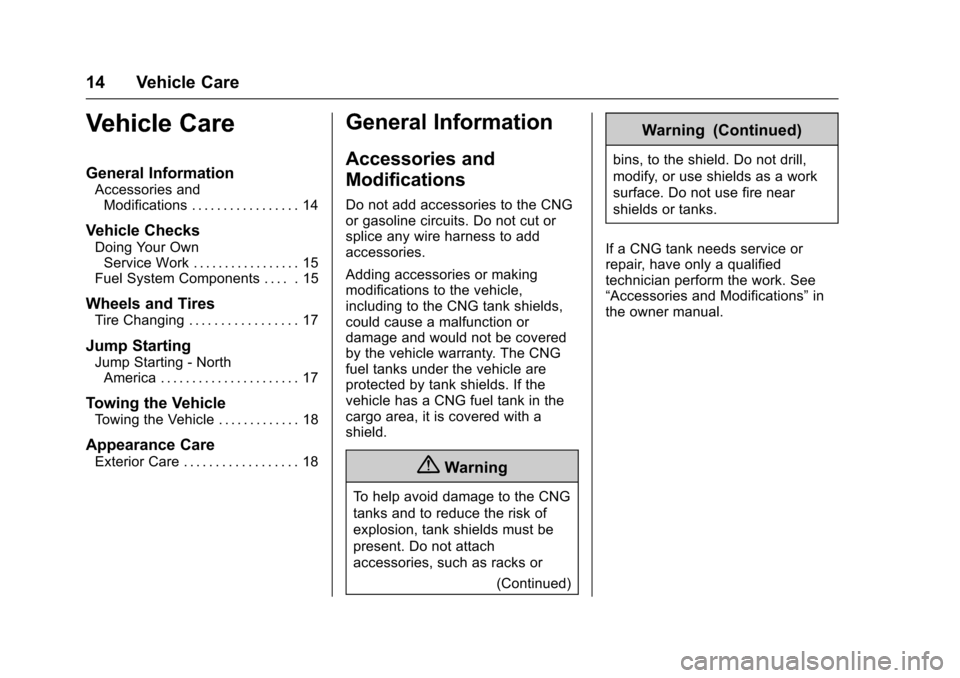
Chevrolet/GMC Express/Savana CNG Compressed Natural Gas Supplement
(GMNA-Localizing-U.S/Canada-9159237) - 2016 - crc - 6/18/15
14 Vehicle Care
Vehicle Care
General Information
Accessories andModifications . . . . . . . . . . . . . . . . . 14
Vehicle Checks
Doing Your OwnService Work . . . . . . . . . . . . . . . . . 15
Fuel System Components . . . . . 15
Wheels and Tires
Tire Changing . . . . . . . . . . . . . . . . . 17
Jump Starting
Jump Starting - North America . . . . . . . . . . . . . . . . . . . . . . 17
Towing the Vehicle
Towing the Vehicle . . . . . . . . . . . . . 18
Appearance Care
Exterior Care . . . . . . . . . . . . . . . . . . 18
General Information
Accessories and
Modifications
Do not add accessories to the CNG
or gasoline circuits. Do not cut or
splice any wire harness to add
accessories.
Adding accessories or making
modifications to the vehicle,
including to the CNG tank shields,
could cause a malfunction or
damage and would not be covered
by the vehicle warranty. The CNG
fuel tanks under the vehicle are
protected by tank shields. If the
vehicle has a CNG fuel tank in the
cargo area, it is covered with a
shield.
{Warning
To help avoid damage to the CNG
tanks and to reduce the risk of
explosion, tank shields must be
present. Do not attach
accessories, such as racks or
(Continued)
Warning (Continued)
bins, to the shield. Do not drill,
modify, or use shields as a work
surface. Do not use fire near
shields or tanks.
If a CNG tank needs service or
repair, have only a qualified
technician perform the work. See
“Accessories and Modifications” in
the owner manual.
Page 16 of 30
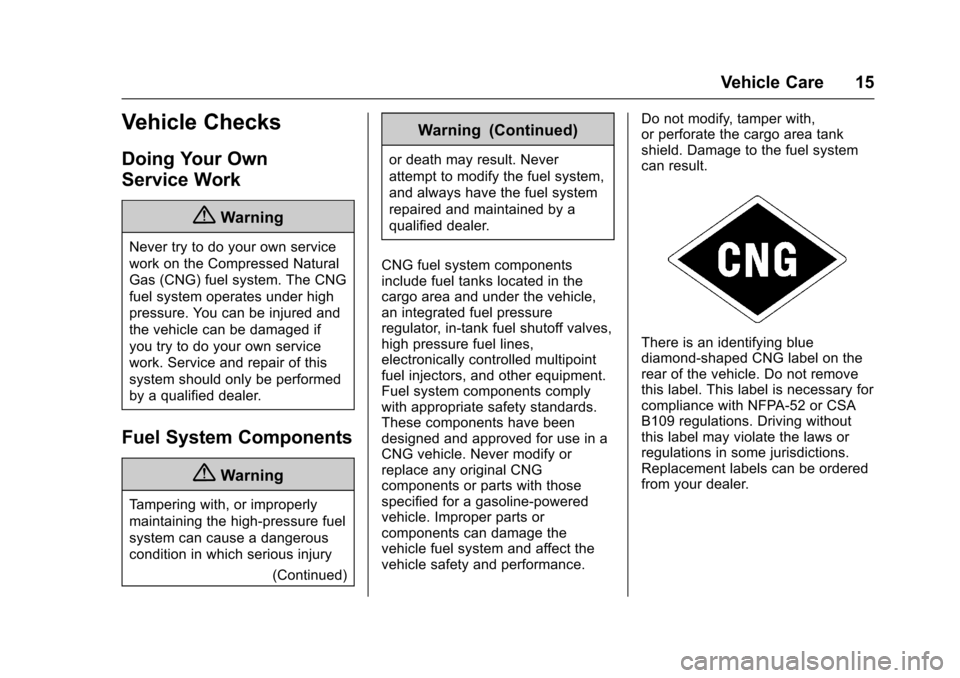
Chevrolet/GMC Express/Savana CNG Compressed Natural Gas Supplement
(GMNA-Localizing-U.S/Canada-9159237) - 2016 - crc - 6/18/15
Vehicle Care 15
Vehicle Checks
Doing Your Own
Service Work
{Warning
Never try to do your own service
work on the Compressed Natural
Gas (CNG) fuel system. The CNG
fuel system operates under high
pressure. You can be injured and
the vehicle can be damaged if
you try to do your own service
work. Service and repair of this
system should only be performed
by a qualified dealer.
Fuel System Components
{Warning
Tampering with, or improperly
maintaining the high-pressure fuel
system can cause a dangerous
condition in which serious injury(Continued)
Warning (Continued)
or death may result. Never
attempt to modify the fuel system,
and always have the fuel system
repaired and maintained by a
qualified dealer.
CNG fuel system components
include fuel tanks located in the
cargo area and under the vehicle,
an integrated fuel pressure
regulator, in-tank fuel shutoff valves,
high pressure fuel lines,
electronically controlled multipoint
fuel injectors, and other equipment.
Fuel system components comply
with appropriate safety standards.
These components have been
designed and approved for use in a
CNG vehicle. Never modify or
replace any original CNG
components or parts with those
specified for a gasoline-powered
vehicle. Improper parts or
components can damage the
vehicle fuel system and affect the
vehicle safety and performance. Do not modify, tamper with,
or perforate the cargo area tank
shield. Damage to the fuel system
can result.
There is an identifying blue
diamond-shaped CNG label on the
rear of the vehicle. Do not remove
this label. This label is necessary for
compliance with NFPA-52 or CSA
B109 regulations. Driving without
this label may violate the laws or
regulations in some jurisdictions.
Replacement labels can be ordered
from your dealer.